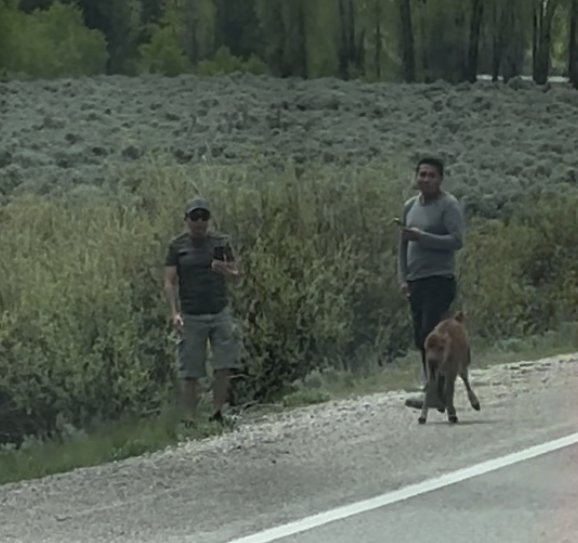National Park Service Seeks Public’s Help in Identifying Wildlife Harassers
Visitors approach baby animals in Yellowstone and Grand Teton
- Published In: Other News & Features
- Last Updated: Jun 10, 2023

Grand Teton National Park officials are seeking the public's help in identifying the individuals in this image who approached a baby bison last week. (Courtesy photo from Grand Teton National Park)
By Melissa Thomasma
Special to the Wyoming Truth
Grand Teton National Park officials are seeking the public’s assistance in identifying two men who approached a baby bison last week.
Two individuals were seen approaching and touching a bison calf at the southern end of Elk Ranch Flats in the park at 1 p.m. on June 4, according to a statement from the National Park Service. The incident is currently under investigation, and anyone who recognizes the men or has information is asked to contact the park.

Grand Teton Chief Ranger Erika Jostad told Wyoming Truth that the men in the photo could face serious legal ramifications for their actions.
“If we locate the suspects, we would cite them with a mandatory appearance in court before the federal magistrate, meaning we would not offer a collateral fine in the field that they could pay and be done,” Jostad said. “They would appear in court, and if found guilty, the magistrate would determine the penalty which could include a monetary fine and or ban from entering Grand Teton National Park.”
The incident comes on the heels of two similar situations in Yellowstone National Park.
On May 31, a Hawaii man pleaded guilty to intentionally disturbing wildlife in the park. “The man grabbed a struggling newborn bison calf and pushed it up from the river and onto the roadway in the northeastern section of the park,” according to the park service statement. “The incident resulted in the death of the calf.” Rangers euthanized the animal, and other incidents with bison are currently under investigation as well.
Yellowstone officials also reported an incident with an elk calf in which “visitors placed an elk calf in their car while likely driving on U.S. Highway 191 in the park and brought the newborn to the West Yellowstone, Montana, Police Department. The elk later ran off into the forest and its condition is unknown.” The event is still under investigation.
“Every day visitors to Yellowstone National Park get inappropriately close to wildlife,” Linda Veress, a public affairs specialist at Yellowstone, told the Wyoming Truth. She described these two recent incidents as “uncommon and severe,” noting that the last time visitor interaction led directly to the death of a bison calf was in 2016.
Why push the boundaries?
National parks present clear rules and guidelines for safely observing and enjoying wildlife of all kinds in their natural habitat. Why, then, are visitors — cell phones in hand — repeatedly approaching wildlife and interacting at an unsafe distance?

Joe Russo, an adjunct professor at the University of Wyoming and expert on social media’s impact on mental health, believes are a few factors are at play.
“The root of all this goes back to the idea of anthropomorphism,” he said in an interview with Wyoming Truth. “Humans have a bias to assign human thinking to animals. We do it with our pets; project onto them.”
Of course, there’s a huge leap between imaging Fido asking for another biscuit and thinking that a grizzly bear is hungry for some online “likes.”
Russo said that as this plays out and is amplified through social media, viewers become desensitized to images of people practically touching wild animals: “What they’re seeing isn’t that it’s a problem. They’re seeing people get away with it.”
Beyond glorifying risky behavior on social media, Russo said many national park visitors are from urban areas and may not have other context for how to safely engage with wild animals. Increasing urbanization, he theorizes, exposes people exclusively to pets and animals like squirrels or pigeons; all larger species are found in zoos. It’s not exactly a blueprint for understanding how serious an enraged mother moose can get.
“What really bothers me is the lack of consequences for these acts,” he said.
Russo would like to see park laws enforced and said that social media platforms bear some responsibility, too. “They need to be quick to contextualize videos like this with a warning: ‘Don’t try this yourself,’” he said.
Stay safe, avoid legal penalties
Valerie Gohlke, public affairs officer for Grand Teton National Park, said human interference can cause wildlife to reject their offspring.
“In this case [June 4 incident] fortunately, the calf was successfully reunited with its herd, but often these interactions result in euthanizing the animal,” she said. “Approaching wildlife can drastically affect their well-being and survival.”
Both Yellowstone and Grand Teton offer strict regulations about safely viewing and interacting with wildlife. Tips include never teasing, touching, frightening or chasing wildlife; never giving animals any kind of human food; and never approaching them too closely even when they appear to be calm. Violation of these regulations can jeopardize the safety of humans and animals alike, and is against the law.
Anyone who has information that could help in the investigation is asked to call the Grand Teton Park tip line: 307-739-3367. Call 911 to report any harassment of wildlife in the parks.













